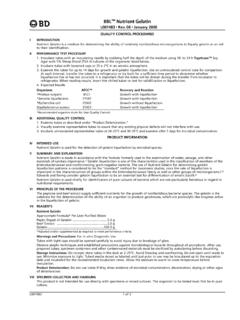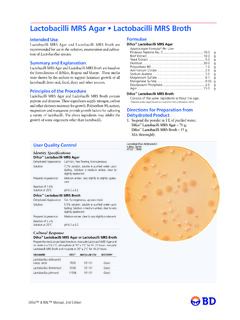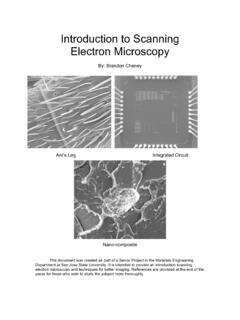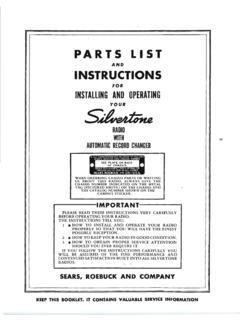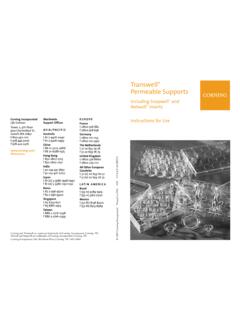Transcription of BACTEC 9240/9120/9050 - BD
1 9000 bc2 RevisionB 7/25/01 Page 1 of 21 AUTOMATED BLOOD CULTURE BACTEC 9240/9120/9050 I. PRINCIPLE The detection of microorganisms in a patient s blood has diagnostic and prognostic importance. Blood cultures are essential in the diagnosis and treatment of the etiologic agents of sepsis. Bacterial sepsis constitutes one of the most serious infectious diseases and, therefore, the expeditious detection and identification of bloodborne bacterial pathogens is an important function of the diagnostic microbiology laboratory. The BACTEC 9000 series of blood culture instruments are designed for the rapid detection of microorganisms in clinical specimens.
2 The sample to be tested is inoculated into the vial which is entered into the BACTEC instrument for incubation and periodic reading. Each vial contains a sensor which responds to the concentration of CO2 produced by the metabolism of microorganisms or the consumption of oxygen needed for the growth of microorgnisms. The sensor is monitored by the instrument every ten minutes for an increase in its fluorescence, which is proportional to the increasing amount of CO2 or the decreasing amount of O2 present in the vial. A positive reading indicates the presumptive presence of viable microorganisms in the vial.
3 II. MATERIAL A. MEDIA 1. BACTEC PLUS Aerobic/F Culture Vial1 Optimum blood volume for each vial is 8 to 10 mL; 3 to 10 mL of blood is acceptable. a. Each vial contains: 25 mL Enriched Soybean-Casein Digest broth (TSB) Sodium Polyanetholesulfonate (SPS) Cationic and Non-ionic Adsorbing Resins Carbon dioxide (CO2) Oxygen (O2) Sensor for the detection of fluorescence b. Store at 2 to 25 C 9000 bc2 RevisionB 7/25/01 Page 2 of 21 2. BACTEC PLUS Anaerobic/F Culture Vial1 Optimum blood volume for each vial is 8 to 10 mL; 3 to 10 mL of blood is acceptable.
4 A. Each vial contains: 25 mL pre-reduced enriched Soybean-Casein Digest broth. SPS Resins CO2 and Nitrogen gas (N2) Sensor for the detection of fluorescence. b. Store at 2 to 25 C. 3. BACTEC PEDS PLUS/F Culture Vial2 Optimum blood volume for each vial is 1 to 3 mL; to 5 mL of blood is acceptable. a. Each vial contains: 40 mL Enriched Soybean-Casein Digest broth SPS Resins CO2 O2 Sensor for the detection of fluorescence. b. Store at 2 to 25 C. 9000 bc2 RevisionB 7/25/01 Page 3 of 21 MEDIA (CONT.) 4. BACTEC MYCO/F LYTIC3 A non-selective culture medium for the recovery of yeast and fungi from blood and body fluids and mycobacteria from blood specimens.
5 The optimum specimen volume is 3 to 5 mL; 1 mL to 5 mL is acceptable. a. Each vial contains: 40 mL Processed Water Middlebrook 7H9 Broth Base Brain Heart Infusion Casein Hydrolysate Supplement H Inositol Glycerol SPS Tween 80 Pyridoxal HCl Ferric Ammonium Citrate Potassium Phosphate Saponin Antifoam CO2 and O2 Sensor for the detection of fluorescence. B. MATERIALS REQUIRED BUT NOT PROVIDED VACUTAINER SAFETY-LOK Blood Collection Set OR 20 mL LUER-LOK syringe with a 21 gauge needle, 3 mL LUER-LOK syringe with a 23 gauge needle, PERSIST Povidone Iodine Prep, 70% isopropyl alcohol (alcohol pads); Biological Safety Cabinet, autoclave; venting units, mycobactericidal disinfectant; microscope, materials for staining slides and subculturing supplies.
6 C. INSTRUMENT 1. BACTEC 9240/9120/9050 ( BACTEC Fluorescent Series) Microorganisms, if present in the blood samples, metabolize nutrients in the BACTEC culture vial and release CO2 into the medium or utilize the oxygen in the medium. The instrument monitors the fluorescence of the vial sensor which increases as CO2 is produced or oxygen is utilized. Analysis of the rate and amount of CO2 produced or O2 utilized enables the instrument to determine if the vial is positive; , the presumptive presence of viable organisms. 9000 bc2 RevisionB 7/25/01 Page 4 of 21 2. Computer and peripherals The system computer stores all the system software, including the application software which controls instrument operations and the user interface, which enables the user to enter patient information, view results, print reports, identify errors, etc.
7 NOTE: The microprocessor associated with each rack is responsible for the actual testing of the vials and positivity analysis. 3. Barcode Scanner The barcode scanner is located on the inside of the instrument to provide the ability to activate barcode commands and to scan vial labels for specimen identification. When the door is opened and an activity is initiated, the scanner is activated and is ready to read the vial The barcode scanner for the BACTEC 9050 is located on the front of the instrument and is activated when the door is opened and the vial entry or vial removal soft keys are III. SPECIMEN A.
8 COLLECTION 1. SITE SELECTION a. Select a different body site for each culture drawn. b. Avoid drawing blood through indwelling intravascular catheters unless blood can not be obtained by venipuncture. Blood collected from intravascular catheters should be done with the knowledge that contamination may be an issue. 2. SITE PREPARATION (PERSIST Povidone Iodine Prep) a. Open the PERSIST package by tearing completely through at the side notches and twisting. b. Leave the package over the end of the swabstick to prevent gloves from becoming covered with solution. c. Apply PERSIST by beginning at the intended venipuncture site, working in a circular motion with friction, covering an area of 2-3 inches in diameter.
9 Do not return to the center of the site once swab has moved outward to the periphery. Persist should be applied with friction and the site prepped 30 seconds to 1 minute. d. Allow PERSIST solution to air dry. e. DO NOT touch or palpate the area after cleansing. 3. DISINFECTING BLOOD CULTURE VIALS- 9000 bc2 RevisionB 7/25/01 Page 5 of 21 a. Remove the flip-off caps from BACTEC culture vials. b. Wipe top of each vial with a separate 70% isopropyl alcohol pad and allow to dry. c. Do not use iodine to disinfect tops of vials. 4. VENIPUNCTURE a. Avoid touching the venipuncture site. If it is necessary to touch the site after it has been cleaned, wipe your fingers with povidone iodine before touching the site.
10 B. When using the Blood Collection Set ( butterfly ) the phlebotomist MUST carefully monitor the volume collected by using the 5 mL graduation marks on the vial label. If the volume is not monitored, the stated maximum amount collected may be exceeded. This condition may adversely create a false positive result, due to high blood background. c. If using a needle and syringe, typically a 20 mL syringe is used for adults. Draw 16 to 20 mL of blood for one blood culture set (aerobic and anaerobic). Aseptically inject 8 to 10 mL of specimen into each vial. Aseptically inject 3 to 5 mL into the MYCO/F LYTIC vial. d. For pediatric patients, a 3 mL syringe is frequently used.
